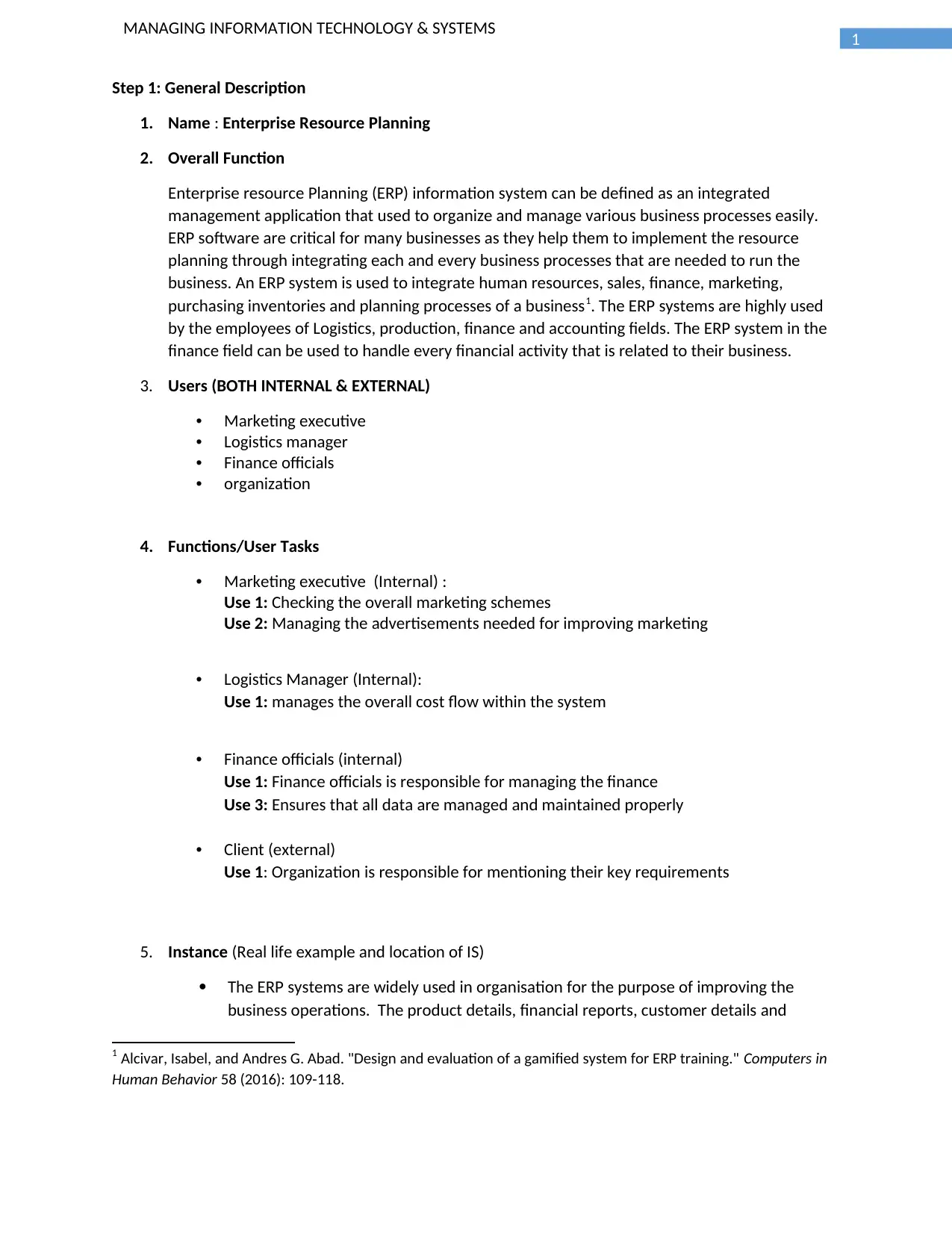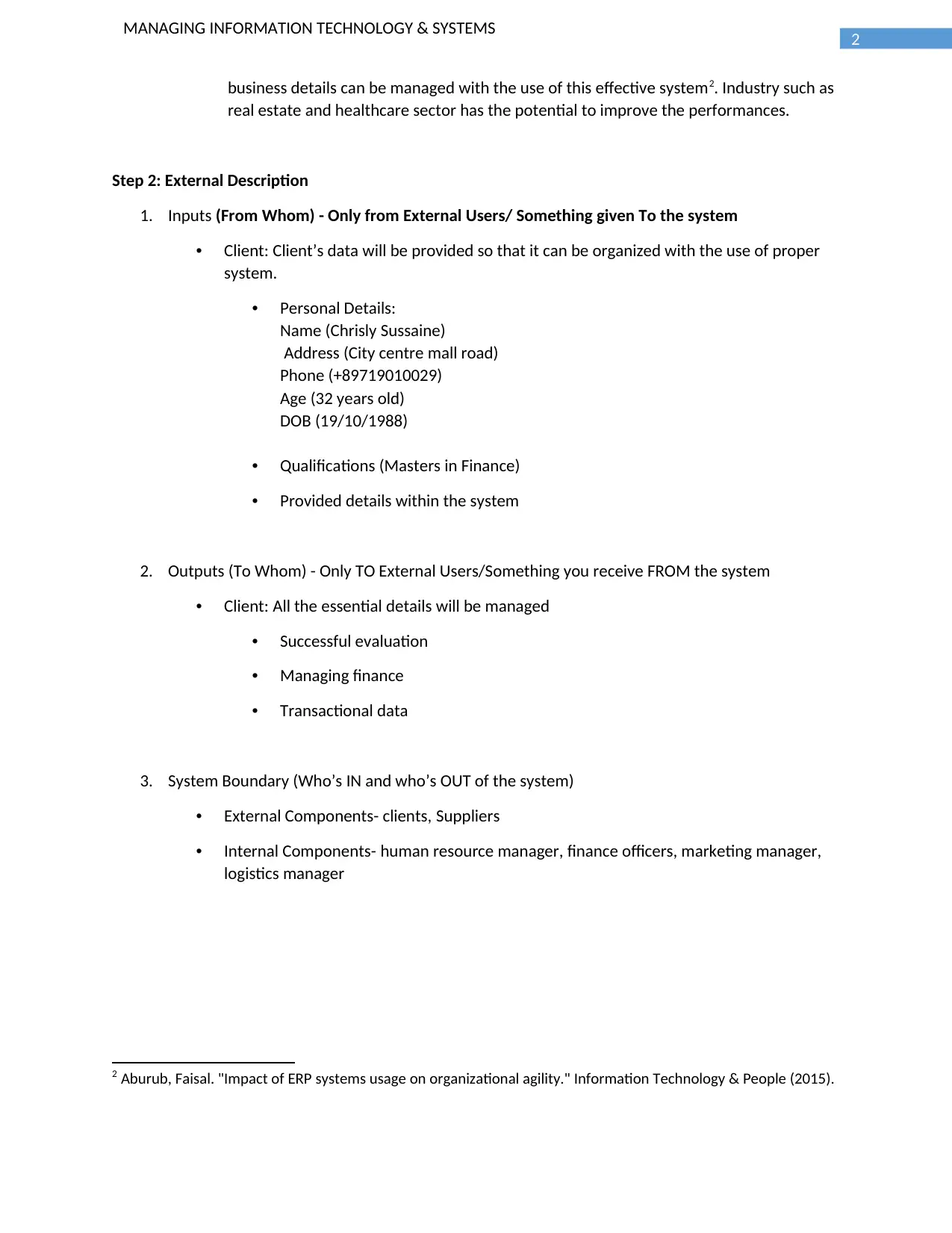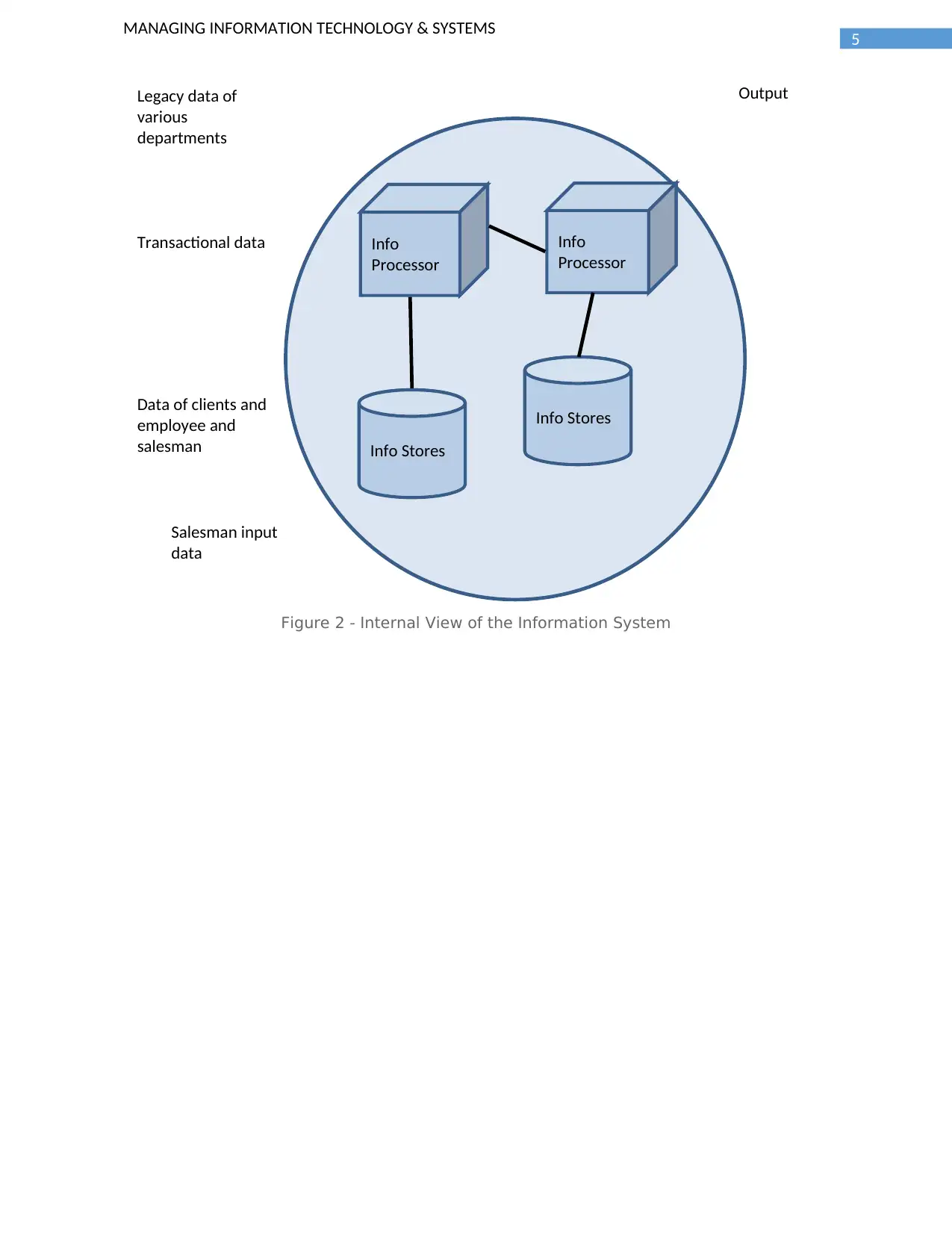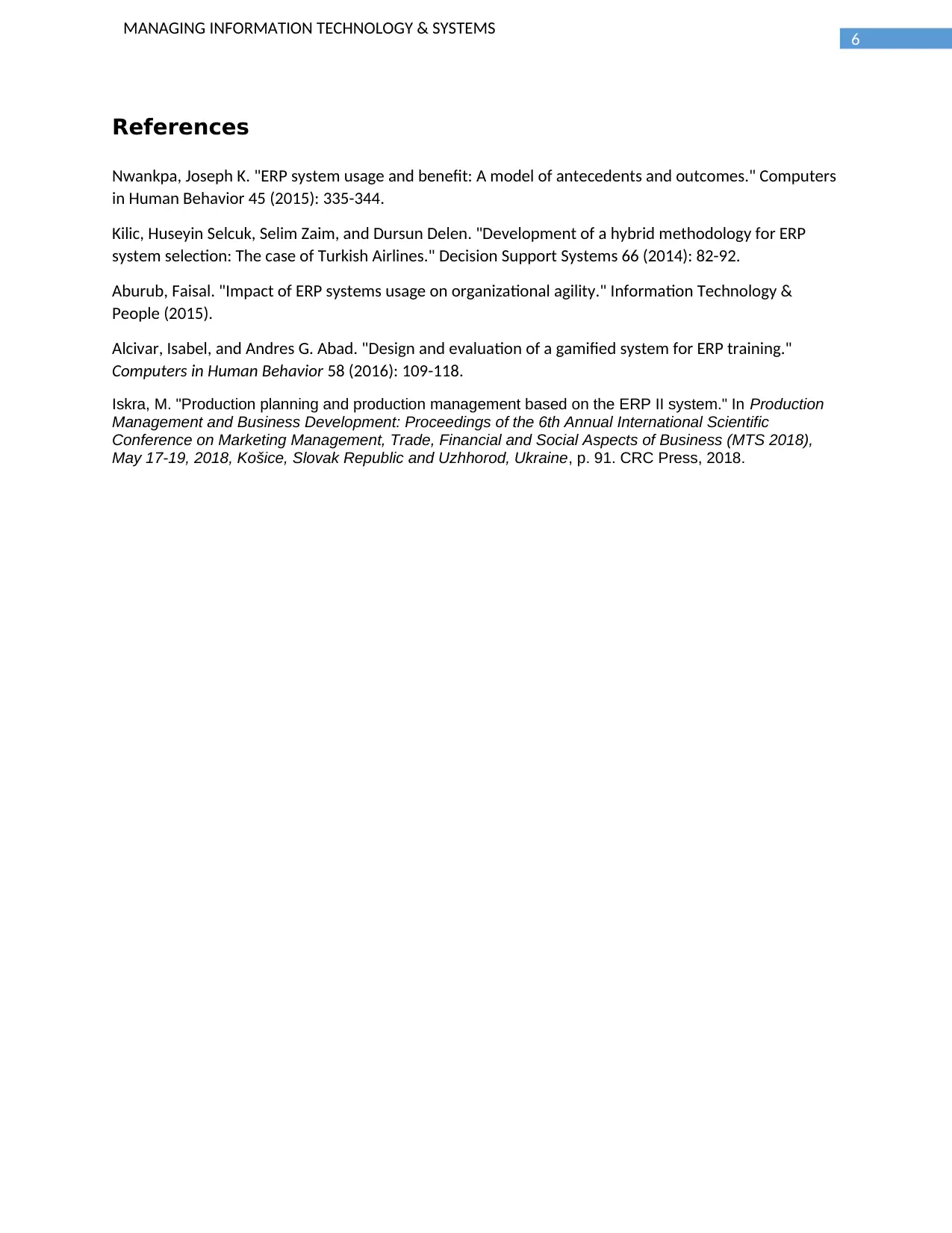Analysis of Enterprise Resource Planning (ERP) Systems Project
VerifiedAdded on 2022/08/20
|7
|1129
|19
Project
AI Summary
This project provides a comprehensive analysis of an Enterprise Resource Planning (ERP) system, detailing its overall function and its role in organizing and managing various business processes. The project begins with a general description of ERP systems, highlighting their importance in integrating various business processes, including human resources, sales, finance, and marketing. It then identifies both internal and external users of the system, such as marketing executives, logistics managers, finance officials, and clients, along with their specific tasks and uses within the system. The project further describes the system's inputs and outputs, focusing on client data and the information provided by and to them. The project also includes external and internal view diagrams to illustrate the flow of information within the ERP system. The internal description delves into the computerized and non-computerized aspects of the system, emphasizing information processing, storage, and network components. References to relevant literature support the analysis. This project aims to demonstrate a clear understanding of ERP systems, their components, and their impact on business operations.

Running head: MANAGING INFORMATION TECHNOLOGY & SYSTEMS
MANAGING INFORMATION TECHNOLOGY & SYSTEMS
Name of the Students
Name of the University
Author Note
MANAGING INFORMATION TECHNOLOGY & SYSTEMS
Name of the Students
Name of the University
Author Note
Paraphrase This Document
Need a fresh take? Get an instant paraphrase of this document with our AI Paraphraser

1
MANAGING INFORMATION TECHNOLOGY & SYSTEMS
Step 1: General Description
1. Name : Enterprise Resource Planning
2. Overall Function
Enterprise resource Planning (ERP) information system can be defined as an integrated
management application that used to organize and manage various business processes easily.
ERP software are critical for many businesses as they help them to implement the resource
planning through integrating each and every business processes that are needed to run the
business. An ERP system is used to integrate human resources, sales, finance, marketing,
purchasing inventories and planning processes of a business1. The ERP systems are highly used
by the employees of Logistics, production, finance and accounting fields. The ERP system in the
finance field can be used to handle every financial activity that is related to their business.
3. Users (BOTH INTERNAL & EXTERNAL)
• Marketing executive
• Logistics manager
• Finance officials
• organization
4. Functions/User Tasks
• Marketing executive (Internal) :
Use 1: Checking the overall marketing schemes
Use 2: Managing the advertisements needed for improving marketing
• Logistics Manager (Internal):
Use 1: manages the overall cost flow within the system
• Finance officials (internal)
Use 1: Finance officials is responsible for managing the finance
Use 3: Ensures that all data are managed and maintained properly
• Client (external)
Use 1: Organization is responsible for mentioning their key requirements
5. Instance (Real life example and location of IS)
The ERP systems are widely used in organisation for the purpose of improving the
business operations. The product details, financial reports, customer details and
1 Alcivar, Isabel, and Andres G. Abad. "Design and evaluation of a gamified system for ERP training." Computers in
Human Behavior 58 (2016): 109-118.
MANAGING INFORMATION TECHNOLOGY & SYSTEMS
Step 1: General Description
1. Name : Enterprise Resource Planning
2. Overall Function
Enterprise resource Planning (ERP) information system can be defined as an integrated
management application that used to organize and manage various business processes easily.
ERP software are critical for many businesses as they help them to implement the resource
planning through integrating each and every business processes that are needed to run the
business. An ERP system is used to integrate human resources, sales, finance, marketing,
purchasing inventories and planning processes of a business1. The ERP systems are highly used
by the employees of Logistics, production, finance and accounting fields. The ERP system in the
finance field can be used to handle every financial activity that is related to their business.
3. Users (BOTH INTERNAL & EXTERNAL)
• Marketing executive
• Logistics manager
• Finance officials
• organization
4. Functions/User Tasks
• Marketing executive (Internal) :
Use 1: Checking the overall marketing schemes
Use 2: Managing the advertisements needed for improving marketing
• Logistics Manager (Internal):
Use 1: manages the overall cost flow within the system
• Finance officials (internal)
Use 1: Finance officials is responsible for managing the finance
Use 3: Ensures that all data are managed and maintained properly
• Client (external)
Use 1: Organization is responsible for mentioning their key requirements
5. Instance (Real life example and location of IS)
The ERP systems are widely used in organisation for the purpose of improving the
business operations. The product details, financial reports, customer details and
1 Alcivar, Isabel, and Andres G. Abad. "Design and evaluation of a gamified system for ERP training." Computers in
Human Behavior 58 (2016): 109-118.

2
MANAGING INFORMATION TECHNOLOGY & SYSTEMS
business details can be managed with the use of this effective system2. Industry such as
real estate and healthcare sector has the potential to improve the performances.
Step 2: External Description
1. Inputs (From Whom) - Only from External Users/ Something given To the system
• Client: Client’s data will be provided so that it can be organized with the use of proper
system.
• Personal Details:
Name (Chrisly Sussaine)
Address (City centre mall road)
Phone (+89719010029)
Age (32 years old)
DOB (19/10/1988)
• Qualifications (Masters in Finance)
• Provided details within the system
2. Outputs (To Whom) - Only TO External Users/Something you receive FROM the system
• Client: All the essential details will be managed
• Successful evaluation
• Managing finance
• Transactional data
3. System Boundary (Who’s IN and who’s OUT of the system)
• External Components- clients, Suppliers
• Internal Components- human resource manager, finance officers, marketing manager,
logistics manager
2 Aburub, Faisal. "Impact of ERP systems usage on organizational agility." Information Technology & People (2015).
MANAGING INFORMATION TECHNOLOGY & SYSTEMS
business details can be managed with the use of this effective system2. Industry such as
real estate and healthcare sector has the potential to improve the performances.
Step 2: External Description
1. Inputs (From Whom) - Only from External Users/ Something given To the system
• Client: Client’s data will be provided so that it can be organized with the use of proper
system.
• Personal Details:
Name (Chrisly Sussaine)
Address (City centre mall road)
Phone (+89719010029)
Age (32 years old)
DOB (19/10/1988)
• Qualifications (Masters in Finance)
• Provided details within the system
2. Outputs (To Whom) - Only TO External Users/Something you receive FROM the system
• Client: All the essential details will be managed
• Successful evaluation
• Managing finance
• Transactional data
3. System Boundary (Who’s IN and who’s OUT of the system)
• External Components- clients, Suppliers
• Internal Components- human resource manager, finance officers, marketing manager,
logistics manager
2 Aburub, Faisal. "Impact of ERP systems usage on organizational agility." Information Technology & People (2015).
⊘ This is a preview!⊘
Do you want full access?
Subscribe today to unlock all pages.

Trusted by 1+ million students worldwide

3
MANAGING INFORMATION TECHNOLOGY & SYSTEMS
ERP
Legacy data of
Department
Transactional
Reports
Transactional Data
Human Resource
Auditing Report
Data of clients and
employees
Financial Reports
Step 3: External View Diagram (External information focus)
Use of Circle, Input/output Arrows
Step 4: Internal Description (Computerized and Non Computerized)
Information processor within ERP system is system that takes information as a form and then
processes the information to other form. The information is fetched in one form, and then processes the
information in other form. When required, the information is decoded from the system and used for its
execution.
Information about financial management, manufacturing, human resource management, and
supply chain management, purchasing and marketing are stored within ERP system of the organization.
MANAGING INFORMATION TECHNOLOGY & SYSTEMS
ERP
Legacy data of
Department
Transactional
Reports
Transactional Data
Human Resource
Auditing Report
Data of clients and
employees
Financial Reports
Step 3: External View Diagram (External information focus)
Use of Circle, Input/output Arrows
Step 4: Internal Description (Computerized and Non Computerized)
Information processor within ERP system is system that takes information as a form and then
processes the information to other form. The information is fetched in one form, and then processes the
information in other form. When required, the information is decoded from the system and used for its
execution.
Information about financial management, manufacturing, human resource management, and
supply chain management, purchasing and marketing are stored within ERP system of the organization.
Paraphrase This Document
Need a fresh take? Get an instant paraphrase of this document with our AI Paraphraser

4
MANAGING INFORMATION TECHNOLOGY & SYSTEMS
Organizations should be aware of ERP system’s several advantage3. ERP system within the organization
would help to keep track of their productivity, enhances compliance, promotes collaboration culture
and gives accurate forecasting of business for the organization. Analytical abilities as well as advanced
databases help in giving accurate forecasts of business by using ERP system within the organization.
Good internal communication networks transferring information within ERP system could make real
difference for the business. When the employees understand purpose and direction of the organization,
they could work towards same goals, where result is more motivated, productive and efficient
workforce. Without regular and clear communication, the employees could become disengaged 4.
Hence, cohesive strategy for internal communications of ERP system is used for successful business.
Within the organization ERP system could be described depending on information’s usage.
Hence, ERP system within an organization could be divided into5 management support system and
operations support system. Within organization, input of data is done by end user that is processed for
generating information products. Managers need precise information within specific format for
undertaking organization decision. Manager is given information by it for facilitating certain solution for
the issues.
Step 5: Internal View Diagram (Internal ICT focus – information processor and stores and networks)
3 Kilic, Huseyin Selcuk, Selim Zaim, and Dursun Delen. "Development of a hybrid methodology for ERP system
selection: The case of Turkish Airlines." Decision Support Systems 66 (2014): 82-92.
4 Iskra, M. "Production planning and production management based on the ERP II system." In Production
Management and Business Development: Proceedings of the 6th Annual International Scientific Conference on
Marketing Management, Trade, Financial and Social Aspects of Business (MTS 2018), May 17-19, 2018, Košice,
Slovak Republic and Uzhhorod, Ukraine, p. 91. CRC Press, 2018.
5 Nwankpa, Joseph K. "ERP system usage and benefit: A model of antecedents and outcomes." Computers in
Human Behavior 45 (2015): 335-344.
MANAGING INFORMATION TECHNOLOGY & SYSTEMS
Organizations should be aware of ERP system’s several advantage3. ERP system within the organization
would help to keep track of their productivity, enhances compliance, promotes collaboration culture
and gives accurate forecasting of business for the organization. Analytical abilities as well as advanced
databases help in giving accurate forecasts of business by using ERP system within the organization.
Good internal communication networks transferring information within ERP system could make real
difference for the business. When the employees understand purpose and direction of the organization,
they could work towards same goals, where result is more motivated, productive and efficient
workforce. Without regular and clear communication, the employees could become disengaged 4.
Hence, cohesive strategy for internal communications of ERP system is used for successful business.
Within the organization ERP system could be described depending on information’s usage.
Hence, ERP system within an organization could be divided into5 management support system and
operations support system. Within organization, input of data is done by end user that is processed for
generating information products. Managers need precise information within specific format for
undertaking organization decision. Manager is given information by it for facilitating certain solution for
the issues.
Step 5: Internal View Diagram (Internal ICT focus – information processor and stores and networks)
3 Kilic, Huseyin Selcuk, Selim Zaim, and Dursun Delen. "Development of a hybrid methodology for ERP system
selection: The case of Turkish Airlines." Decision Support Systems 66 (2014): 82-92.
4 Iskra, M. "Production planning and production management based on the ERP II system." In Production
Management and Business Development: Proceedings of the 6th Annual International Scientific Conference on
Marketing Management, Trade, Financial and Social Aspects of Business (MTS 2018), May 17-19, 2018, Košice,
Slovak Republic and Uzhhorod, Ukraine, p. 91. CRC Press, 2018.
5 Nwankpa, Joseph K. "ERP system usage and benefit: A model of antecedents and outcomes." Computers in
Human Behavior 45 (2015): 335-344.

5
MANAGING INFORMATION TECHNOLOGY & SYSTEMS
Legacy data of
various
departments
Output
Info
Processor
Info Stores
Info
Processor
Info Stores
Transactional data
Data of clients and
employee and
salesman
Salesman input
data
Figure 2 - Internal View of the Information System
MANAGING INFORMATION TECHNOLOGY & SYSTEMS
Legacy data of
various
departments
Output
Info
Processor
Info Stores
Info
Processor
Info Stores
Transactional data
Data of clients and
employee and
salesman
Salesman input
data
Figure 2 - Internal View of the Information System
⊘ This is a preview!⊘
Do you want full access?
Subscribe today to unlock all pages.

Trusted by 1+ million students worldwide

6
MANAGING INFORMATION TECHNOLOGY & SYSTEMS
References
Nwankpa, Joseph K. "ERP system usage and benefit: A model of antecedents and outcomes." Computers
in Human Behavior 45 (2015): 335-344.
Kilic, Huseyin Selcuk, Selim Zaim, and Dursun Delen. "Development of a hybrid methodology for ERP
system selection: The case of Turkish Airlines." Decision Support Systems 66 (2014): 82-92.
Aburub, Faisal. "Impact of ERP systems usage on organizational agility." Information Technology &
People (2015).
Alcivar, Isabel, and Andres G. Abad. "Design and evaluation of a gamified system for ERP training."
Computers in Human Behavior 58 (2016): 109-118.
Iskra, M. "Production planning and production management based on the ERP II system." In Production
Management and Business Development: Proceedings of the 6th Annual International Scientific
Conference on Marketing Management, Trade, Financial and Social Aspects of Business (MTS 2018),
May 17-19, 2018, Košice, Slovak Republic and Uzhhorod, Ukraine, p. 91. CRC Press, 2018.
MANAGING INFORMATION TECHNOLOGY & SYSTEMS
References
Nwankpa, Joseph K. "ERP system usage and benefit: A model of antecedents and outcomes." Computers
in Human Behavior 45 (2015): 335-344.
Kilic, Huseyin Selcuk, Selim Zaim, and Dursun Delen. "Development of a hybrid methodology for ERP
system selection: The case of Turkish Airlines." Decision Support Systems 66 (2014): 82-92.
Aburub, Faisal. "Impact of ERP systems usage on organizational agility." Information Technology &
People (2015).
Alcivar, Isabel, and Andres G. Abad. "Design and evaluation of a gamified system for ERP training."
Computers in Human Behavior 58 (2016): 109-118.
Iskra, M. "Production planning and production management based on the ERP II system." In Production
Management and Business Development: Proceedings of the 6th Annual International Scientific
Conference on Marketing Management, Trade, Financial and Social Aspects of Business (MTS 2018),
May 17-19, 2018, Košice, Slovak Republic and Uzhhorod, Ukraine, p. 91. CRC Press, 2018.
1 out of 7
Related Documents
Your All-in-One AI-Powered Toolkit for Academic Success.
+13062052269
info@desklib.com
Available 24*7 on WhatsApp / Email
![[object Object]](/_next/static/media/star-bottom.7253800d.svg)
Unlock your academic potential
Copyright © 2020–2025 A2Z Services. All Rights Reserved. Developed and managed by ZUCOL.




